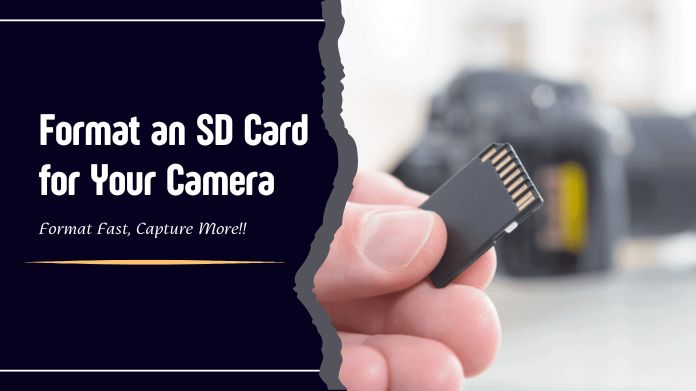Have you ever taken out your camera for a big shoot only to find that your SD card isn’t working correctly or is filled with outdated photos? It might be aggravating, but there’s an easy solution: format an SD card.
Whether you’re a novice or an experienced photographer, formatting your card is an important step in keeping things working properly.
But how precisely do you do this? When should you format your SD card?
In this post, I’ll walk you through the process, explain why it’s necessary, and show you a couple of simple methods to accomplish it, regardless of the device you’re using.
Ready to get started? Let’s dive in!
When and Why to Format an SD Card?

There are many instances in which formatting an SD card is essential. For example, formatting a fresh SD card before usage is an excellent way to assure compatibility with your camera.
Similarly, formatting the card before a large shoot will assist in avoiding potential issues such as file corruption or errors during recording.
Furthermore, if you begin to encounter difficulties or notice that your card is filling up abnormally rapidly, formatting can reset the file system, erasing all data and addressing these issues.
Formatting is advantageous since it removes all data from the card, thereby returning it to a blank state.
This operation also reconfigures the file system, preventing data corruption and ensuring that your SD card runs optimally.
Different Methods to Format an SD Card
According to your device or operating system, you can format an SD card in one of numerous ways.
Whether you format directly in your camera, on a computer, or using the SD card formatter tool, each method has advantages.
The approach you use may be determined by your equipment, personal preferences, or unique requirements.
Method 1: Format an SD Card Using the Camera
Formatting your SD card directly in the camera is often the easiest and most reliable method.
This method ensures that the card is formatted according to the standards of your camera’s file system, lowering the likelihood of compatibility difficulties.
Step-by-Step Guide:
- First, take your SD card and insert it into your camera. Now, go ahead and turn on your camera.
- Once it’s powered up, have you ever noticed the menu option? That’s where you’ll need to go next.
- Head over to the settings or setup section—can you find the format option there? When you do, select it.
- Before you hit confirm, though, have you backed up all your important data? Formatting will erase everything on the card, so it’s always good to double-check.
- After you confirm, the camera will do the rest. And just like that, your SD card is ready for your next shoot!
Method 2: Format an SD Card on Windows
If you prefer using a computer, Windows provides a straightforward way to format an SD card. This method is particularly useful if you want to ensure compatibility with multiple devices.
Steps for Windows Users:
- First, you must enter your SD card into your computer’s card reader.
- Once you’ve done that, head over to File Explorer—do you see the SD card listed under “This PC”? Great!
- Now try right-clicking the SD card. Notice the “Format” choice that appears. Go ahead and click it.
- For most cameras, FAT32 is the way to go, but if you’re dealing with larger cards, exFAT might be better. Ready to start the process?
- Simply select “Start,” and your SD card will be fully formatted and ready to use in no time. How simple was that?
Method 3: Format an SD Card on Android
For those who don’t have immediate access to a computer, formatting an SD card on an Android device is a convenient option.
Steps for Android Users:
- First, take your SD card and insert it into your Android handset.
- Next, navigate to “Settings” and then find the “Storage” option. Have you found it? Great!
- Now, select your SD card from the list. You’ll see an option to “Format.” Go ahead and tap on it.
- Confirm the formatting operation, and your SD card will be newly formatted and ready for use in your camera or any other device you require.
Method 4: Format an SD Card on a Mac
Mac users may format their SD cards using Disk Utility, a sophisticated utility that is included in MacOS.
How to Format an SD card on Mac:
- First, take your SD card and pop it into your Mac’s card reader.
- Now, simply navigate to your Applications folder and open Disk Utility.
- Once you’re there, you’ll see a list of drives; go ahead and select your SD card.
- Now, here’s the important part: click on the “Erase” tab. You’ll need to choose the right file system for your needs, then hit “Erase.”
- And just like that, once the process is done, your SD card is ready to go. Easy, right?
Method 5: Format an SD Card Using an SD Card Formatter
Usually, the formatting tools that come with Mac and Windows can handle SD cards, but they might not be the best choice for SD/SDHC/SDXC cards, which could lead to slower performance.
To do so, you can go through the SD Card Formatter; it is best for both Windows and Mac.
Steps for using an SD Card Formatter:
- First, you’ll want to download SD card formatter tool.
- Next, fire up the SD Formatter application. You’ll see an option to select the drive letter for your SD card—just pick the right one.
- Go ahead and hit ‘format.’ When you’re sure you’re ready, click ‘yes’ to confirm the process.
Tips for Ensuring SD Card Health
Maintaining the health of your SD card goes beyond just formatting. Regularly formatting your card after backing up data is one way to extend its lifespan.
Moreover, avoid exposing your SD card to severe temperatures or physical damage. Using high-quality card readers and maintaining your SD card carefully can also help retain its usefulness.
A tip from personal experience: I always carry a small, protective case for my SD cards to keep them safe from physical damage and dust.
It’s a simple measure, but it’s saved me from potential data loss on more than one occasion.
Final Thoughts
All photographers should format their SD cards on a regular basis. It doesn’t matter if you’re using your camera, a Windows PC, an Android phone, or a Mac—the important thing is to keep your SD card in excellent condition to avoid problems or errors.
So, before your next large shoot, spend a few minutes formatting your SD card.
Believe me, you’ll be pleased you did!
